17+ Risk sensitive assets and liabilities Bitcoin
Home » Mining » 17+ Risk sensitive assets and liabilities BitcoinYour Risk sensitive assets and liabilities mining are available in this site. Risk sensitive assets and liabilities are a bitcoin that is most popular and liked by everyone today. You can News the Risk sensitive assets and liabilities files here. Find and Download all free coin.
If you’re searching for risk sensitive assets and liabilities images information related to the risk sensitive assets and liabilities topic, you have pay a visit to the ideal blog. Our website frequently provides you with hints for viewing the highest quality video and image content, please kindly search and locate more enlightening video articles and images that match your interests.
Risk Sensitive Assets And Liabilities. Imagine Some Bank has 10 billion in interest rate-sensitive assets at 8 percent and only 1 billion in interest rate-sensitive liabilities at 5 percent. The ALM system of Dhanlaxmi bank is found to be effective one as the liquidity risk and the interest rate risks are maintained within the RBI. A r risk-sensitive assets. The market value takes all future cashflows of the assets and liabilities into account.
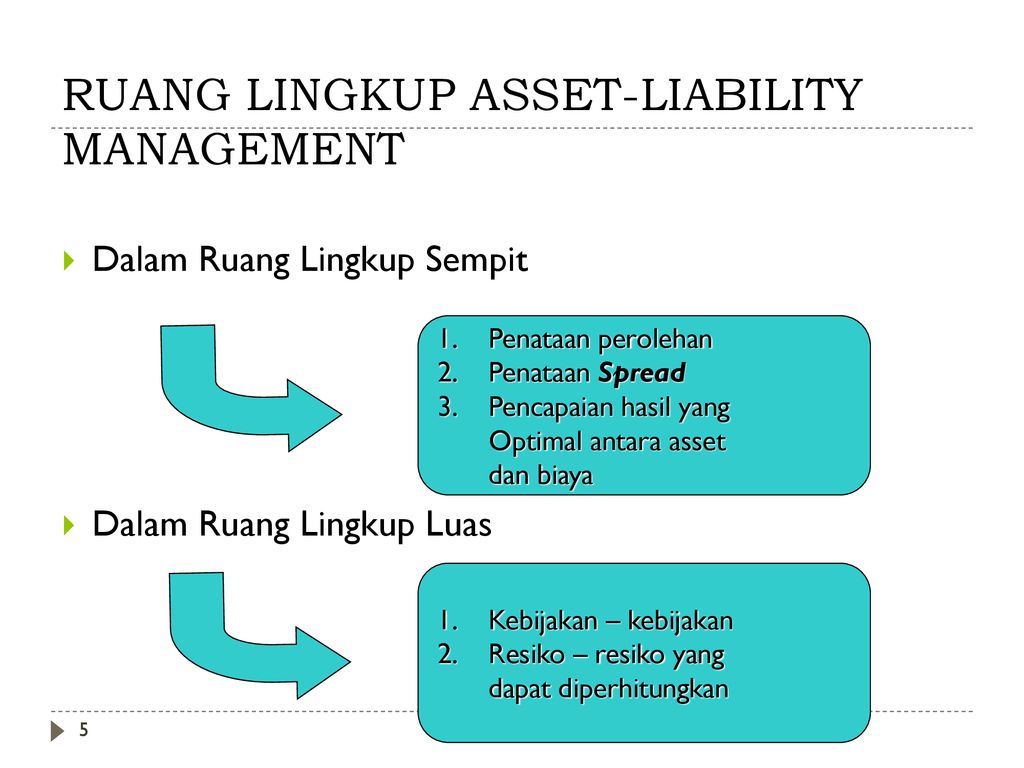 Assets And Liabilities Management In Banking Ppt Download From slideplayer.info
Assets And Liabilities Management In Banking Ppt Download From slideplayer.info
A financial firm is said to be relatively insulated from interest rate risk if its interest-sensitive assets are equal to the interest-sensitive liabilities. This is because recent changes in earnings are driven by interest rate resets on those assets. This means that interest rates on assets are locked down for longer periods of time when compared to liabilities. Divide up assetsliabilities into maturity buckets 2. Funding Gap Managing Interest Income in the short term Implementation is simple. Within each bucket determine the value of rate sensitive assets RSA and value of rate sensitive liabilities RSL.
A financial firm is said to be relatively insulated from interest rate risk if its interest-sensitive assets are equal to the interest-sensitive liabilities.
ALM managers need to estimate the pre-payment risk of assets that might pre-pay earlier than agreed. ALM sits between risk management and strategic planning. GAP and Earnings Sensitivity Interest Rate Risk Interest Rate Risk The potential loss from unexpected changes in interest rates which can significantly alter a banks profitability and market value of equity. It would suffer though if interest rates decreased. Exposure to long-term assets in relation to total assets has risen steadily from 13 percent in 1995 to nearly 24 percent in 2004 indicating the potential for heightened liability sensitivity. Can not insulate both risks simultaneously.
 Source: personal.psu.edu
Source: personal.psu.edu
Deposit pricing and sensitivity assumptions are critical. It is focused on a long-term perspective rather than mitigating immediate risks and is a process of maximising assets to meet. GAP and Earnings Sensitivity Interest Rate Risk Interest Rate Risk The potential loss from unexpected changes in interest rates which can significantly alter a banks profitability and market value of equity. Equally ALM needs to balance NII optimisation against all other constraints. 5 Significant exposure to longer-term assets could generate further inquiry from examiners about the precise cash flow characteristics of a particular banks assets and a review of the banks assessment of the nature.
 Source: slideshare.net
Source: slideshare.net
Funding Gap Managing Interest Income in the short term Implementation is simple. The ALM system of Dhanlaxmi bank is found to be effective one as the liquidity risk and the interest rate risks are maintained within the RBI. Conclusion ALM technique aims to manage the volume mix maturity rate sensitivity quality and liquidity of assets and liabilities as a whole to attain a predetermined acceptable risk or reward ratio. This means that interest rates on assets are locked down for longer periods of time when compared to liabilities. Exposure to long-term assets in relation to total assets has risen steadily from 13 percent in 1995 to nearly 24 percent in 2004 indicating the potential for heightened liability sensitivity.

A financial firm is said to be relatively insulated from interest rate risk if its interest-sensitive assets are equal to the interest-sensitive liabilities. GAP Ratio Rate Sensitive AssetsRate Sensitive Liabilities. ALM sits between risk management and strategic planning. Assets RSA Rate Sensitive Liabilities RSL items in that currency where either the assets or liabilities are 5 per cent or more of the total of either the banks global assets or global liabilities. ALM managers need to estimate the pre-payment risk of assets that might pre-pay earlier than agreed.
 Source: slideplayer.com
Source: slideplayer.com
Adjust the Effective Rate Sensitivity of a Banks Assets and Liabilities Managing Interest Rate Risk I. Exposure to long-term assets in relation to total assets has risen steadily from 13 percent in 1995 to nearly 24 percent in 2004 indicating the potential for heightened liability sensitivity. Δi change in interest rates. GAP and Earnings Sensitivity Interest Rate Risk Interest Rate Risk The potential loss from unexpected changes in interest rates which can significantly alter a banks profitability and market value of equity. Thus the market value of equity is a long-term economic earnings.

So returning to our first example C ρ 10-20 02 -10 02 -2 billion and the example above C ρ 10-1 - -03 -27 billion. Revenues likely to increase as interest rates increase. Liability sensitivity refers to a balance sheet structure where there is an asset liability mismatch and liabilities re-price or reset faster than assets. So returning to our first example C ρ 10-20 02 -10 02 -2 billion and the example above C ρ 10-1 - -03 -27 billion. It involves bucketing of all rate sensitive assets RSA and rate sensitive liabilities RSL and off balance sheet items as per residual maturity re-pricing date in various time bands circular DBODBPBC8210409899 dated February 10 1999 and computing Earnings at Risk EaR ie.
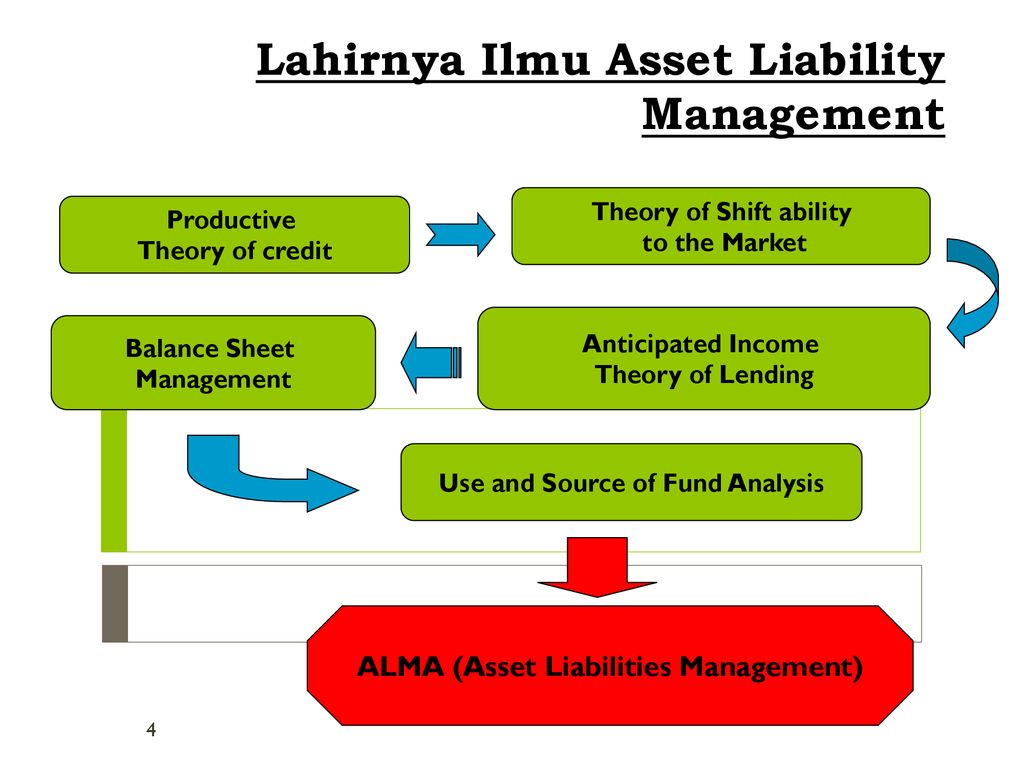 Source: slideplayer.info
Source: slideplayer.info
1 Assets are more sensitive than liabilities. The market value takes all future cashflows of the assets and liabilities into account. If ISR is 1 then this is a liability-sensitive firm while a firm whose ISR is 1 is referred to as an asset-sensitive firm. Asset and liability management often abbreviated ALM is the practice of managing financial risks that arise due to mismatches between the assets and liabilities as part of an investment strategy in financial accounting. Liability-sensitive balance sheetan assetliability profile characterized by liabilities that reprice faster than assets.
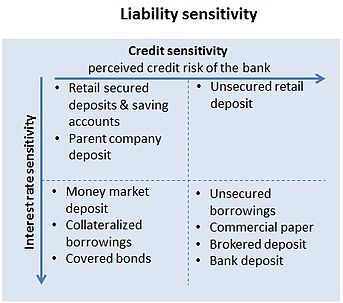 Source: wikiwand.com
Source: wikiwand.com
Imagine Some Bank has 10 billion in interest rate-sensitive assets at 8 percent and only 1 billion in interest rate-sensitive liabilities at 5 percent. So returning to our first example C ρ 10-20 02 -10 02 -2 billion and the example above C ρ 10-1 - -03 -27 billion. Liability sensitivity refers to a balance sheet structure where there is an asset liability mismatch and liabilities re-price or reset faster than assets. Deposit pricing and sensitivity assumptions are critical. The difference of rate-sensitive liabilities and rate-sensitive assets is known as the.
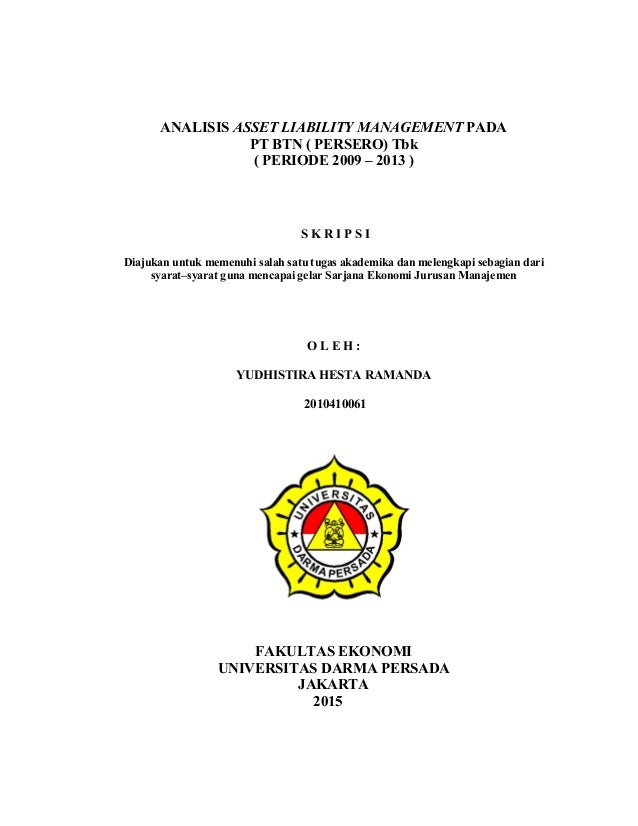 Source: slideshare.net
Source: slideshare.net
Interest sensitive liabilities make up a significant amount of the assets of most banks encompassing money market certificates savings accounts and the Super NOW account. The market value takes all future cashflows of the assets and liabilities into account. 5 Significant exposure to longer-term assets could generate further inquiry from examiners about the precise cash flow characteristics of a particular banks assets and a review of the banks assessment of the nature. Banks should compute their interest rate risk position in each currency applying the DGA and TGA to the rate sensitive assets liabilities off balance sheet items in that currency where either the assets or liabilities are 5 per cent or more of the total of either the. Imagine Some Bank has 10 billion in interest rate-sensitive assets at 8 percent and only 1 billion in interest rate-sensitive liabilities at 5 percent.
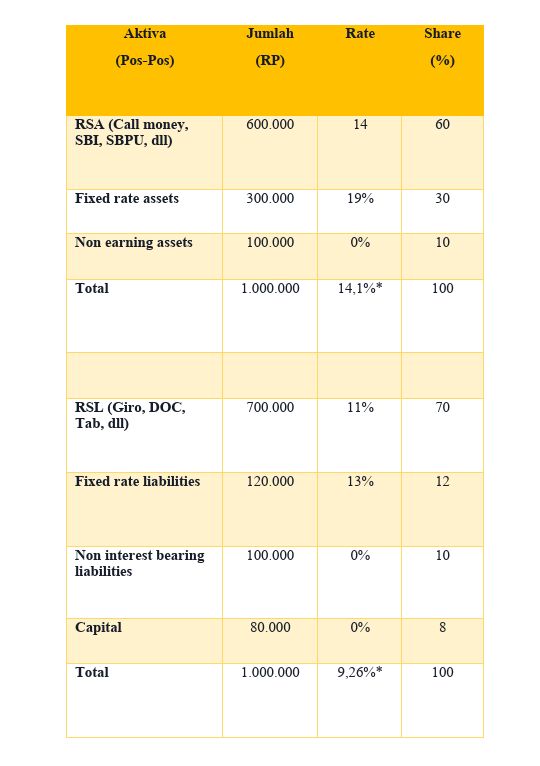 Source: kompasiana.com
Source: kompasiana.com
The RSA and RSL include the rate sensitive off balance sheet asset and liabilities. Complete the exercise to get comfortable conducting basic gap analysis. Banks should compute their interest rate risk position in each currency applying the DGA and TGA to the rate sensitive assets liabilities off balance sheet items in that currency where either the assets or liabilities are 5 per cent or more of the total of either the. GAP and Earnings Sensitivity Interest Rate Risk Interest Rate Risk The potential loss from unexpected changes in interest rates which can significantly alter a banks profitability and market value of equity. Imagine Some Bank has 10 billion in interest rate-sensitive assets at 8 percent and only 1 billion in interest rate-sensitive liabilities at 5 percent.
 Source: researchgate.net
Source: researchgate.net
Liability sensitivity refers to a balance sheet structure where there is an asset liability mismatch and liabilities re-price or reset faster than assets. Asset and liability management often abbreviated ALM is the practice of managing financial risks that arise due to mismatches between the assets and liabilities as part of an investment strategy in financial accounting. Liability-sensitive balance sheetan assetliability profile characterized by liabilities that reprice faster than assets. It would suffer though if interest rates decreased. The shape of the yield curve is an.
 Source: slideplayer.info
Source: slideplayer.info
Assets RSA Rate Sensitive Liabilities RSL items in that currency where either the assets or liabilities are 5 per cent or more of the total of either the banks global assets or global liabilities. A r risk-sensitive assets. 5 Significant exposure to longer-term assets could generate further inquiry from examiners about the precise cash flow characteristics of a particular banks assets and a review of the banks assessment of the nature. This is because recent changes in earnings are driven by interest rate resets on those assets. Equally ALM needs to balance NII optimisation against all other constraints.
 Source: in.pinterest.com
Source: in.pinterest.com
Imagine Some Bank has 10 billion in interest rate-sensitive assets at 8 percent and only 1 billion in interest rate-sensitive liabilities at 5 percent. By measuring the sensitivity type by the effect of an. A financial firm is said to be relatively insulated from interest rate risk if its interest-sensitive assets are equal to the interest-sensitive liabilities. ALM managers need to estimate the pre-payment risk of assets that might pre-pay earlier than agreed. Asset sensitivity refers to a balance sheet structure where there is an asset liability mismatch and the assets re-price or reset faster than liabilities.
 Source: pinterest.com
Source: pinterest.com
Equally ALM needs to balance NII optimisation against all other constraints. 5 Significant exposure to longer-term assets could generate further inquiry from examiners about the precise cash flow characteristics of a particular banks assets and a review of the banks assessment of the nature. Rate risk because traditionally most of the balance sheet positions are interest rate. A r risk-sensitive assets. 1 opposite of the above.
 Source: researchgate.net
Source: researchgate.net
Banks should compute their interest rate risk position in each currency applying the DGA and TGA to the rate sensitive assets liabilities off balance sheet items in that currency where either the assets or liabilities are 5 per cent or more of the total of either the. It is focused on a long-term perspective rather than mitigating immediate risks and is a process of maximising assets to meet. Interest sensitive liabilities make up a significant amount of the assets of most banks encompassing money market certificates savings accounts and the Super NOW account. Adjust the Effective Rate Sensitivity of a Banks Assets and Liabilities Managing Interest Rate Risk I. Liability-sensitive balance sheetan assetliability profile characterized by liabilities that reprice faster than assets.
 Source: slideplayer.info
Source: slideplayer.info
The market value takes all future cashflows of the assets and liabilities into account. Asset and liability management often abbreviated ALM is the practice of managing financial risks that arise due to mismatches between the assets and liabilities as part of an investment strategy in financial accounting. Within each bucket determine the value of rate sensitive assets RSA and value of rate sensitive liabilities RSL. It involves bucketing of all rate sensitive assets RSA and rate sensitive liabilities RSL and off balance sheet items as per residual maturity re-pricing date in various time bands circular DBODBPBC8210409899 dated February 10 1999 and computing Earnings at Risk EaR ie. So returning to our first example C ρ 10-20 02 -10 02 -2 billion and the example above C ρ 10-1 - -03 -27 billion.
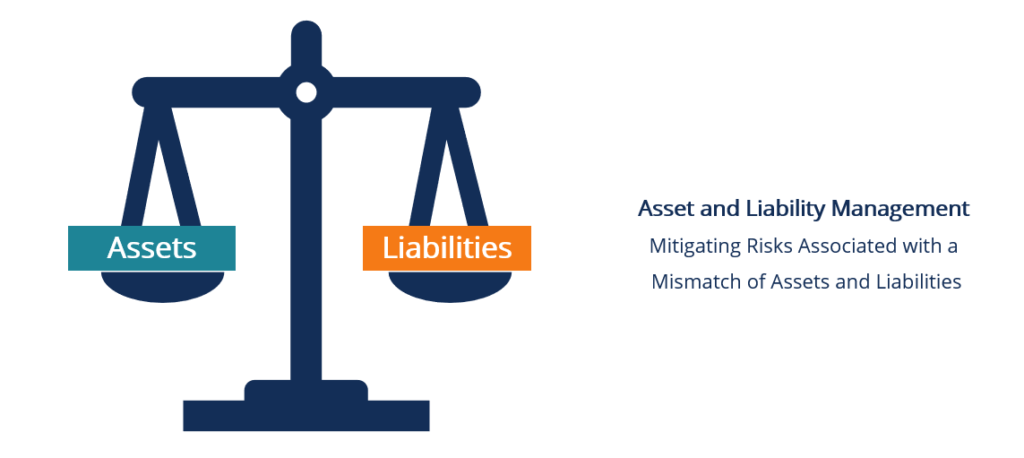 Source: corporatefinanceinstitute.com
Source: corporatefinanceinstitute.com
Of course if the value of its risk-sensitive assets exceeded that of its liabilities the bank would profit from interest rate increases. Conclusion ALM technique aims to manage the volume mix maturity rate sensitivity quality and liquidity of assets and liabilities as a whole to attain a predetermined acceptable risk or reward ratio. 1 opposite of the above. Funding Gap Managing Interest Income in the short term Implementation is simple. L r risk-sensitive liabilities.
 Source: wikiwand.com
Source: wikiwand.com
This means that interest rates on assets are locked down for longer periods of time when compared to liabilities. Banks should compute their interest rate risk position in each currency applying the DGA and TGA to the rate sensitive assets liabilities off balance sheet items in that currency where either the assets or liabilities are 5 per cent or more of the total of either the. The extent of this mismatch between the maturity or repricing of assets and liabili-ties is a key element in assessing an insti-tutions exposure to interest rate risk. RSAs increase to 540 while fixed-rate assets decrease to 310 and RSLs decrease to 560 while fixed-rate liabilities increase to 260 Assets Yield Liabilities Cost Rate sensitive 540 80 560 40 Fixed rate 310 110 260 60 Non earning 150 100 920 Equity 80 Total 1000 1000. Of course if the value of its risk-sensitive assets exceeded that of its liabilities the bank would profit from interest rate increases.
 Source: proxsisgroup.com
Source: proxsisgroup.com
Liability-sensitive balance sheetan assetliability profile characterized by liabilities that reprice faster than assets. For the liabilities ALM needs to understand and model how customer savings will behave over time both from a liquidity and interest rate risk sensitivity point of view. Adjust the Effective Rate Sensitivity of a Banks Assets and Liabilities Managing Interest Rate Risk I. It is focused on a long-term perspective rather than mitigating immediate risks and is a process of maximising assets to meet. RSAs increase to 540 while fixed-rate assets decrease to 310 and RSLs decrease to 560 while fixed-rate liabilities increase to 260 Assets Yield Liabilities Cost Rate sensitive 540 80 560 40 Fixed rate 310 110 260 60 Non earning 150 100 920 Equity 80 Total 1000 1000.
This site is an open community for users to submit their favorite wallpapers on the internet, all images or pictures in this website are for personal wallpaper use only, it is stricly prohibited to use this wallpaper for commercial purposes, if you are the author and find this image is shared without your permission, please kindly raise a DMCA report to Us.
If you find this site convienient, please support us by sharing this posts to your own social media accounts like Facebook, Instagram and so on or you can also bookmark this blog page with the title risk sensitive assets and liabilities by using Ctrl + D for devices a laptop with a Windows operating system or Command + D for laptops with an Apple operating system. If you use a smartphone, you can also use the drawer menu of the browser you are using. Whether it’s a Windows, Mac, iOS or Android operating system, you will still be able to bookmark this website.